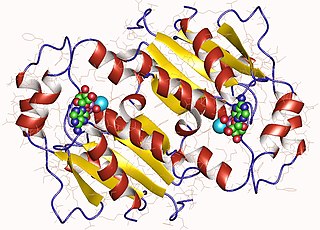
In chemistry, phosphorylation of a molecule is the attachment of a phosphoryl group. This process and its inverse, dephosphorylation, are critical for many cellular processes in biology. Protein phosphorylation is especially important for their function; for example, this modification activates almost half of the enzymes present in Saccharomyces cerevisiae, thereby regulating their function. Many proteins are phosphorylated temporarily, as are many sugars, lipids, and other biologically-relevant molecules.

A phosphoprotein is a protein that is posttranslationally modified by the attachment of either a single phosphate group, or a complex molecule such as 5'-phospho-DNA, through a phosphate group. The target amino acid is most often serine, threonine, or tyrosine residues, or aspartic acid or histidine residues.

Phosphoserine is an ester of serine and phosphoric acid. Phosphoserine is a component of many proteins as the result of posttranslational modifications. The phosphorylation of the alcohol functional group in serine to produce phosphoserine is catalyzed by various types of kinases. Through the use of technologies that utilize an expanded genetic code, phosphoserine can also be incorporated into proteins during translation.

In enzymology, a phosphoribosylformylglycinamidine synthase (EC 6.3.5.3) is an enzyme that catalyzes the chemical reaction
In enzymology, a beta-glucoside kinase is an enzyme that catalyzes the chemical reaction
In enzymology, a diphosphate-serine phosphotransferase is an enzyme that catalyzes the chemical reaction

In enzymology, a gluconokinase is an enzyme that catalyzes the chemical reaction
In enzymology, a low-density-lipoprotein receptor kinase is an enzyme that catalyzes the chemical reaction
In enzymology, a phosphoglucan, water dikinase (EC 2.7.9.5) is an enzyme that catalyzes the chemical reaction
In enzymology, a polynucleotide 5'-hydroxyl-kinase is an enzyme that catalyzes the chemical reaction
In enzymology, a protein-histidine pros-kinase is an enzyme that catalyzes the chemical reaction
In enzymology, a protein-histidine tele-kinase is an enzyme that catalyzes the chemical reaction

In enzymology, a tau-protein kinase is an enzyme that catalyzes the chemical reaction

Eukaryotic translation initiation factor 2A (eIF2A) is a protein that in humans is encoded by the EIF2A gene. The eIF2A protein is not to be confused with eIF2α, a subunit of the heterotrimeric eIF2 complex. Instead, eIF2A functions by a separate mechanism in eukaryotic translation.
The Eukaryotic Linear Motif (ELM) resource is a computational biology resource for investigating short linear motifs (SLiMs) in eukaryotic proteins. It is currently the largest collection of linear motif classes with annotated and experimentally validated linear motif instances.

The Journal of Proteome Research is a peer-reviewed scientific journal published since 2002 by the American Chemical Society. Its publication frequency switched from bimonthly to monthly in 2006. The current editor-in-chief is John R. Yates.
Cell Signaling Technology, Inc. (CST) is a privately held company that develops and produces antibodies, ELISA kits, ChIP kits, proteomic kits, and other related reagents used to study the cell signaling pathways that impact human health. CST maintains an in-house research program, particularly in the area of cancer research, and has published scientific papers in many peer-reviewed journals.

Chromosome 11 open reading frame one, also known as C11orf1, is a protein-coding gene. It has been found by yeast two hybrid screen to bind to SETDB1 a histone protein methyltransferase enzyme. SETDB1 has been implicated in Huntington's disease, a neurodegenerative disorder.
Phospho3D is a database of 3D structures of phosphorylation sites derived from Phospho.ELM.

Phosphomimetics are amino acid substitutions that mimic a phosphorylated protein, thereby activating the protein. Within cells, proteins are commonly modified at serine, tyrosine and threonine amino acids by adding a phosphate group. Phosphorylation is a common mode of activating or deactivating a protein as a form of regulation. However some non-phosphorylated amino acids appear chemically similar to phosphorylated amino acids. Therefore, by replacing an amino acid, the protein may maintain a higher level of activity. For example, aspartic acid is chemically similar to phospho-serine. Therefore, when an aspartic acid replaces a serine, it is a phosphomimetic of phospho-serine and can make the protein always in its phosphorylated form. Phosphonate-based compounds have been used as phosphotyrosine analogues, as they are less enzyme labile and are physiologically more stable.








